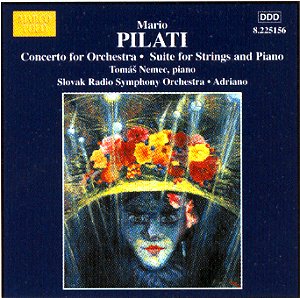The curiously mono-nomenclatured conductor, Adriano,
also writes the extensive programme notes for this CD. This he does
passionately and with considerable persuasion, but he says (and this
is quite likely to put listeners off), Pilati’s output "over a period
of only eighteen years is already full of surprises and of great maturity,
leading the present writer not to hesitate in regarding him as a genius."
Mario Pilati was born in Naples in 1903 and is therefore
some 25 years younger than the Respighi and Casella generation and belongs
to a disparate group of composers which includes Petrassi, Dallapiccola,
Rieti and Nino Rota. In truth he does not fit into that group. His short,
and one must say unfulfilled, life never allowed him a chance fully
to develop, to have his music promoted or to be taken up by leading
figures. Much of it remains published. These factors never allowed the
composer to develop his burgeoning and promising voice.
There is enough on this CD to show that Pilati, who
was very prolific, was a promising and very fine composer. A great one
… ? Well, perhaps Marco Polo will allow us more opportunities in the
future to decide on that one.
There are certainly times when a career in films might
well have been ideal for Pilati (e.g., the Forlana in the ‘Three
Pieces’ and the third movement of the ‘Concerto for Orchestra’
when I could almost see an Italian Malcolm Arnold peeping out between
the ravioli and the pasta.
In retrospect I probably made an error when I first
listened to this disc. I decided to listen in chronological order, beginning
with the less representative ‘Suite’ of 1925. My next selection followed
the sequence of the CD with the longest and most impressive work being
the so-called ‘Concerto for Orchestra’. Although the booklet
reminds us of works of similar title by Bartók, Lutoslawski etc,
it also informs us that one of Pilati’s favourite composers in the '20s
was Ernest Bloch who composed his first and best known ‘Concerto
Grosso’ in 1924 (the 2nd not until in 1951). It is the
baroque idea of 'concerto', that informs this piece, with its grand
opening Prelude. The contrapuntal basis of the second and third movements
hides the main theme of the opening but the return of this theme is
the basis for the cyclic nature of the work. The piano at times seems
like a soloist. The E minor second movement is neo-classical in perception
with its ornamentations in the piano, string and wind figurations in
a baroque manner but with romantic harmonies. I personally find the
sound of the piano in the texture unconvincing and it brings to mind
the sound of a theatre orchestra trying unsuccessfully to be serious.
Indeed the scoring in general is a mixture of the Hollywood MGM sound
of the 1930-40s tweaked with reminders that baroque music should be
more hair-shirt than passion.
The ‘Three Pieces’ consist of three dances,
a Minuetto, a Habanera and a Furlana. These are
very attractive works deliciously, nicely and convincingly scored -
the influence of Ravel can surely be heard here. I am thinking of ‘Le
Tombeau de Couperin’ (1917) but also in the Habanera a touch
of ‘La Valse’. There is a colourful use of percussion throughout
especially at the opening of the Furlana. The harmony is rich and was
quite probably was considered rather modern for its time.
The ‘Suite’ is a strongly neo-classical work in which
the piano dominates. The booklet is graced with a lovely sepia photograph
of Pilati and his small orchestra at the time of its first performance.
The Sarabande is a perfect work of its type and style as is the Minuet,
so reminiscent of Ravel and even Fauré.
The disc ends touchingly, with Pilati’s last work,
written as he was literally on his death bed, a ‘Cradle Song’, really
a melancholy Berceuse for one might say, his own slumber. It
is scored for five wind instruments, celesta, harp and strings. It is
a work that should be better known and any readers who work for Classic
FM would find it an ideal advert for the world’s most beautiful music.
The recording is perfectly good and well balanced.
I have little criticism of the orchestra except that the strings seem
to be not quite on top of the demands in parts of the Concerto.
For a number of years now early 20th Century
Italian music has, thanks to Marco Polo, been getting more exposure.
There is so much more to Italian art music of that era than Puccini
and Respighi. Well worth investigating.
Gary Higginson

![]() Slovak Radio SO/Adriano
Slovak Radio SO/Adriano![]() MARCO POLO
8.225156 [61.05]
MARCO POLO
8.225156 [61.05]